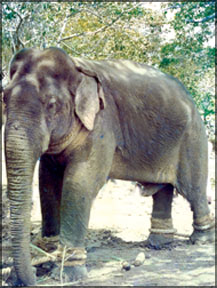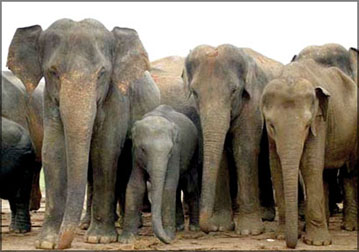|
Nature trail
Kraals...
How our ancestors captured elephants
Elephant, the largest mammal on Earth, never fails to fascinate us.
We’ve been featuring these majestic pachyderms many times in Nature
trail recently because there is so much to learn about them. They’ve
always been a part of our cultures, pageantry, folklore and life.
 |
|
The stockade
built for the capture of elephants. |
Even though these wild animals could be dangerous, man has somehow
mastered the art of capturing and taming them to do various things such
as carry logs, go in processions during peraheras, perform various acts
at circuses and zoos, and even play polo. So, how do you think people
succeeded in taming them?
In today’s article, we’ll enlighten you briefly as to how people
managed to capture these huge wild animals in the past.Elephants have
been hunted from ancient times mainly for their tusks, for sport, and
also to be domesticated and used for work and as a mode of transport.
This has been happening from time immemorial all over the world. It
happens even today even though the world elephant population is fast
dwindling. History records that in ancient times people hunted elephants
with bows and arrows. But today modern weapons and techniques are used
to hunt and capture them.
However, when it comes to capturing elephants for work and other
purposes, measures have to be taken to ensure that the animals are not
harmed in any way. Injuries, even minor ones need to be minimised.
During British rule a large number of elephants were killed with the
permission of the government, mostly when huge areas of land were
cleared for plantations such as tea and rubber.
Wild elephants were also killed as a sport and for their tusks by the
British. In fact, the AGA of Badulla, Major Thomas William Rogers
(1834-1845) is famed as one of the greatest elephant hunters of that
time. He is reported to have shot and killed more than 1,400 of these
giants of the jungle. Major Thomas Skinner and Captain Galleway are also
well-known for their expertise in hunting elephants.
Major Skinner is reported to have killed around 600 wild elephants
during his time. The period between 1840-1850 is recorded as a time when
the most number of elephants were killed by the British. Even Sir Samuel
Baker is said to have been a great hunter during that era.
According to historical documents, our ancestors began domesticating
these giants more than 3000 years ago. But the traditional techniques
used then were very primitive and more often than not caused injury to
the animals.
The elephants were captured by noosing them, setting various traps
such as large pits where the elephants fell into or by feeding
intoxicating medicines. However, due to the high incidence of injuries,
these methods were prohibited and better techniques introduced.
According to the Secretary of the Elephant Owners’ Association,
Dhamsiri Bandara, during the reign of the British, a highly skilled band
of able-bodied men had been employed to capture the elephants. Even the
legendry Raja had been caught by such a specialised elephant hunter.
Now, let’s find out how our ancestors succeeded in capturing not one,
but many elephants in one attempt during those days.
Documented reports reveal that our ancestors adopted a method known
as the Kheddahs or Kraal(Corral) system to capture large numbers of
elephants. It is believed that the word kraal may be a corruption of the
Sinhala word gaal by the Portuguese and Dutch.
Between the period 1820 and 1900 alone, more than 50 such kraals are
believed to have been held in various parts of the country. The first
kraal is recorded to have been held in 1820 at a place called
Galkadawata near Kala Oya. Dhamsiri explained how this mammoth operation
was carried out in the past....
He said that a kraal is organised by the disawe of the area or
another such high ranking official with the permission of the
government, sometimes purely for the purpose of obtaining elephants for
domestication or even in honour of various foreign dignitaries.
Hundreds of able-bodied men and at least half a dozen tame elephants
to control the captured wild cousins are needed to conduct a kraal.
Initially, an area which is densely populated with elephants is
demarcated for this purpose. Then with the use of heavy logs the
triangular shaped stockade covering a large area of land into which the
elephants are chased, (sometimes from about a 30 mile distance) is built
according to facts given in the book Ali-Eththu. Holes as deep as four
feet are dug up along the boundary of the selected area and 10 foot high
logs are placed as posts. These are tied up to build the strong fence
with horizontally placed logs, three-feet apart.
The fenced up area or the stockade is divided into cross sections,
leaving a narrow but large enough passage at the tip of the triangle for
the elephants to enter. This fence is called the ravul weta in Sinhala.
At the end of this passage is a small gate through which the elephant
enters the main area and this is called the Kangula.As soon as all the
elephants come through this gate, it is fenced up and so the elephant
hunters call it the evelema bandina weta (the fence that is built
instantly.)
All the elephants that come through the kangula enter an area called
the rahas gala (the hidden or secret kraal)which is located in the
centre of the fenced area. From this section, the elephants are driven
into another section known as the kelinagala (playing kraal) through yet
another opening such as the kangula.
A water hole is necessary bait in a kraal and it was usually located
within the kelinagala. The elephants are not kept here for long. They
are once again chased into another section called the hira gala (prison
kraal).
 |
|
In kraals
elephants were not tied up like this. They had some freedom
of movement. |
The exhausted, but ferocious elephants that enter this section in
file formation (one behind the other) through a passage are eventually
tied up one by one using strong ropes made of madu or jungle creepers in
a special area called the anda with the assistance of two tamed
elephants to control the wild one.
How the elephants are lured into the kraal.
A band of able-bodied men entrusted with the task chase the elephants
from three or four directions shouting continuously, beating drums and
hitting at trees with long sticks. At night, fire-torches are used to
drive the elephants towards the stockade.
“So no matter in which direction the elephants ran, all they heard
were the deafening sounds of beating drums and people shouting,” said
Bandara.
The ‘beaters’ line was known as the rekma (watch), the longer sides
of the area from which the elephants were being chased as the diga rekma
(long watch) and the shorter sides as the haras rekma (transverse
watch).
The elephants trapped within this area had no choice but to run into
the fenced section of the kraal where they were finally tied up and
domesticated. Many who were not submissive had been either shot or freed
into the jungles. The whole operation of chasing or driving the
elephants which lasted over a period of two months was known as kele
gaseema, said Bandara.
-Asha Senevirathne
The infamous Panamure kraal
Where it was held:
 The
infamous Panamure kraal was carried out in August 1950 in Kolonna in the
Ratnapura district. About eight acres of land from the 54,000 acres of
jungle which belonged to then Speaker of the House of Representatives,
Sir Francis Molamure had been cordoned off for this operation. Around
thousand villagers had been recruited and 12-14 female elephants had
also been brought in to control the wild elephants in this major
elephant kraal. The
infamous Panamure kraal was carried out in August 1950 in Kolonna in the
Ratnapura district. About eight acres of land from the 54,000 acres of
jungle which belonged to then Speaker of the House of Representatives,
Sir Francis Molamure had been cordoned off for this operation. Around
thousand villagers had been recruited and 12-14 female elephants had
also been brought in to control the wild elephants in this major
elephant kraal.
In order to prevent any elephants dying from exhaustion after being
chased a long distance by the villagers, a huge waterway too had been
built within the compound of the kraal.
It is said that the villagers succeeded in capturing 17 elephants at
the end of this huge operation. They had succeeded in noosing all except
one stubborn elephant which revolted violently furious that its herd was
caught; the elephant had reacted strongly, making it virtually
impossible for the men to bring it under control.
Even though Sir Francis Molamure had ordered that it be set free, the
elephant had refused to escape leaving behind its herd. As a result it
had eventually been shot down raising a huge public outcry over its
death and the inhuman manner in which elephants were being captured.
This eventually led to the banning of such operations in the country.The
last kraal is said to have been held in 1952.
 Today
only for very special purposes, permits are issued by the government to
capture elephants and that too is done using modern methods, such as
drug immobilization minimising any form of injury to the animals. Today
only for very special purposes, permits are issued by the government to
capture elephants and that too is done using modern methods, such as
drug immobilization minimising any form of injury to the animals.
A programme conducted by the Pinnawala Elephant Orphanage and also
the Elephant Owners’ Association helps meet the country’s requirements
of tamed elephants.
In fact, the Association helps to protect these captured elephants,
train them and also their mahouts.
The President of the Elephant Owners’ Association. Diyawadana Nilame,
Nilanga Dela Bandara and the Secretary, Dhamsiri Bandara are the
officials responsible for conducting these programmes.
The Zoological Garden and various religious institutes are provided
elephants from Pinnawala. At times we also present elephants to other
countries, explained Dhamsiri Bandara. |
